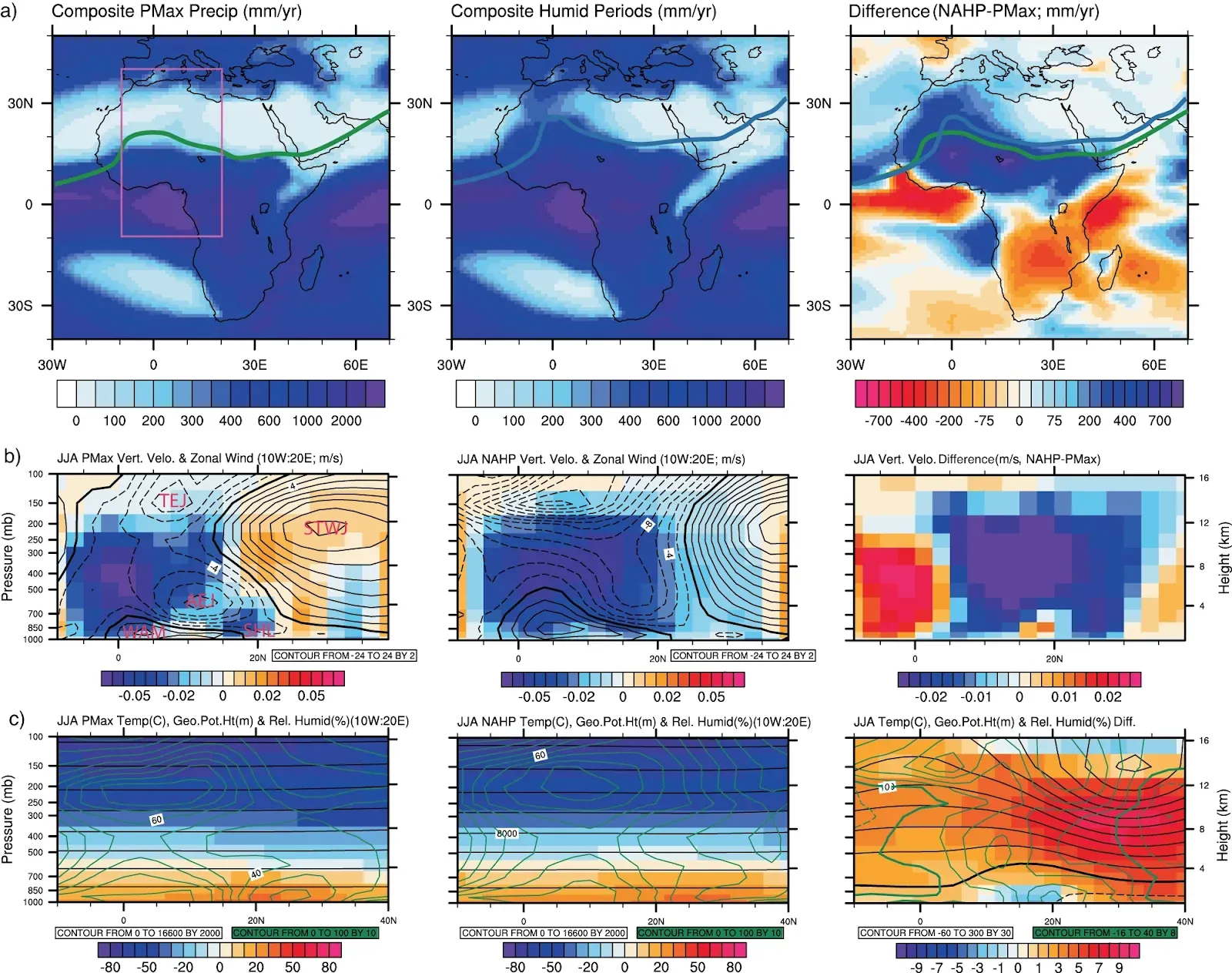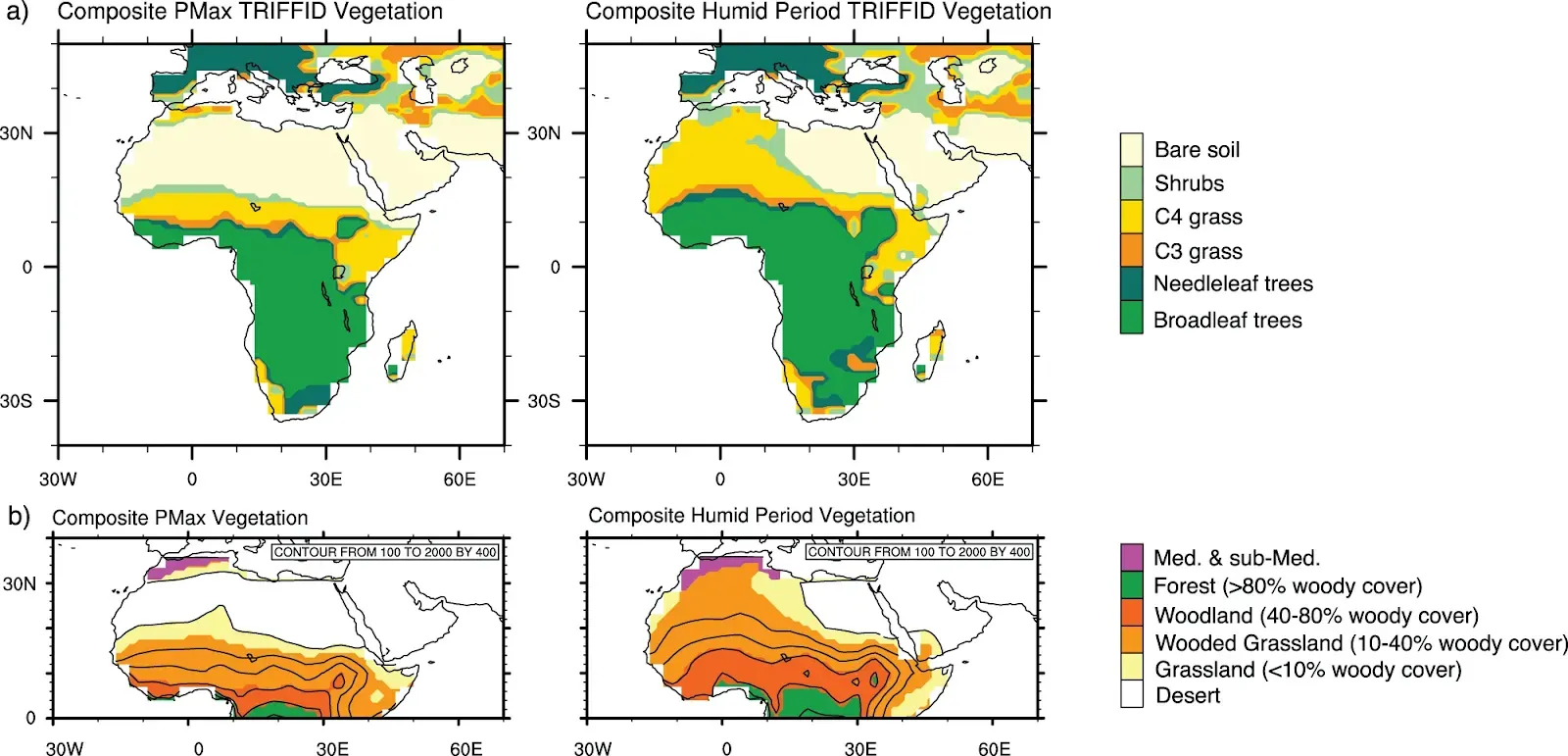
Scientists led by Dr Edward Armstrong, a climate scientist with Bristol University, UK, have successfully modelled the climate history of North Africa and shown that the Sahara Desert had periods of greening, with rivers, lakes and savannah-like grasslands.
These periods of greening explain the evidence of water-dependent species such as hippos. Their research is published open access in the journal Nature Communications.
This evidence adds support to the 'Sahara Pump' hypothesis:
What was the so-called 'Sahara Pump' and what was its significance for the evolution of mammals?Amongst the species that could have migrated north to the Mediterranean basin using the 'Sahara Pump' were early humans.
The "Sahara Pump" hypothesis is a scientific theory that suggests the expansion and contraction of the Sahara Desert in North Africa played a significant role in shaping the evolution of mammals, particularly during the Cenozoic era, which began around 66 million years ago and continues to the present day. Here's how the Sahara Pump hypothesis works and its significance:In summary, the Sahara Pump hypothesis suggests that the dynamic changes in the Sahara's size and climate over millions of years influenced the evolution of mammals by creating opportunities for isolation, speciation, and adaptation. It underscores the interconnectedness of climate change, geography, and the evolution of Earth's biodiversity, particularly in the African context.
- Climate Changes: Over geological time, the Earth's climate has undergone various changes. During the Cenozoic era, there were periods of both cooling and warming. During the cooling periods, the Sahara Desert expanded, becoming a vast arid region. During warming periods, it contracted, leading to the creation of more hospitable environments.
- Habitat Fragmentation: As the Sahara expanded during cooling periods, it acted as a barrier, effectively splitting Africa into two distinct regions: a northern, arid region (the Sahara itself) and a southern, more lush region. This division resulted in the isolation of plant and animal populations on either side of the desert.
- Isolation and Speciation: Isolation is a key driver of speciation, the process by which new species evolve. When populations are separated, they can diverge over time due to different selective pressures and genetic drift. This isolation led to the development of distinct lineages and new species.
- Migration and Dispersal: During warming periods, the Sahara Desert would contract, allowing for the dispersal and migration of species between the previously isolated regions. This movement of species between northern and southern Africa facilitated gene flow, which could result in hybridization and the exchange of genetic diversity.
- Evolutionary Innovation: The Sahara Pump hypothesis suggests that this cyclic expansion and contraction of the desert played a role in the evolution of mammals by driving innovation and adaptation. Some researchers propose that certain adaptations, such as improved water retention mechanisms and heat tolerance, may have been favored in species inhabiting the desert or bordering regions.
- Fossil Evidence: Fossil evidence and genetic studies have provided support for this hypothesis, showing patterns of speciation and dispersal that correspond with the changing Sahara landscape.
The scientists' research is explained in a Bristol University News release:
A pioneering study has shed new light on North African humid periods that have occurred over the past 800,000 years and explains why the Sahara Desert was periodically green.More detail is given in the team's open access paper and accompanying charts in Nature Communications:
The research, published in Nature Communications, showed periodic wet phases in the Sahara were driven by changes in Earth’s orbit around the Sun and were suppressed during the ice ages.
For the first time, climate scientists simulated the historic intervals of ‘greening’ of the Sahara, offering evidence for how the timing and intensity of these humid events were also influenced remotely by the effects of large, distant, high-latitude ice sheets in the Northern Hemisphere.
There is widespread evidence that the Sahara was periodically vegetated in the past, with the proliferation of rivers, lakes and water-dependent animals such as hippos, before it became what is now desert. These North African Humid Periods may have been crucial in providing vegetated corridors out of Africa, allowing the dispersal of various species, including early humans, around the world.The cyclic transformation of the Sahara Desert into savannah and woodland ecosystems is one of the most remarkable environmental changes on the planet. Our study is one of the first climate modelling studies to simulate the African Humid Periods with comparable magnitude to what the palaeoclimate observations indicate, revealing why and when these events occurred.
Dr Edward Armstrong, lead author
Climate scientist
University of Helsinki, Finland and University of Bristol, UK
The so-called ‘greenings’ are thought to have been driven by changes in Earth’s orbital conditions, specifically Earth’s orbital precession. Precession refers to how Earth wobbles on its axis, which influences seasonality (i.e. the seasonal contrast) over an approximate 21,000-year cycle. These changes in precession determine the amount of energy received by the Earth in different seasons, which in turn controls the strength of the African Monsoon and the spread of vegetation across this vast region.
A major barrier to understanding these events is that the majority of climate models have been unable to simulate the amplitude of these humid periods, so the specific mechanisms driving them have remained uncertain.
This study deployed a recently-developed climate model to simulate the North African Humid periods to greatly advance understanding of their driving mechanisms.
The results confirm the North African Humid Periods occurred every 21,000 years and were determined by changes in Earth’s orbital precession. This caused warmer summers in the Northern Hemisphere, which intensified the strength of the West African Monsoon system and increased Saharan precipitation, resulting in the spread of savannah-type vegetation across the desert.We are really excited about the results. Traditionally, climate models have struggled to represent the extent of the ‘greening’ of the Sahara. Our revised model successfully represents past changes and also gives us confidence in their ability to understand future change.
Professor Paul Valdes, co-author
Professor of Physical Geography
University of Bristol, UK.
The findings also show the humid periods did not occur during the ice ages, when there were large glacial ice sheets covering much of the high latitudes. This is because these vast ice sheets cooled the atmosphere and suppressed the tendency for the African monsoon system to expand. This highlights a major teleconnection between these distant regions, which may have restricted the dispersal of species, including humans, out of Africa during the glacial periods of the last 800,000 years.The Sahara region is kind of a gate controlling the dispersal of species between both North and Sub-Saharan Africa, and in and out of the continent. The gate was open when Sahara was green and closed when deserts prevailed. This alternation of humid and arid phases had major consequences for the dispersal and evolution of species in Africa. Our ability to model North African Humid periods is a major achievement and means we are now also better able to model human distributions and understand the evolution of our genus in Africa.
Tallavaara Miikka, Co-author
Assistant Professor of Hominin Environments
University of Helsinki, Finland.
The research, including climate scientists from the University of Birmingham, is part of a Kone Foundation-funded project at the University of Helsinki, which studies the impacts of climate on past human distributions and evolution of their ecological niche.
AbstractThe problem for creationists here is that, even if they manage to shoehorn these climate changes into a mere 10,000 years, they then have to explain why at least the later periods of greening went unnoticed by, for example, the Egyptians, since there is no record of them in any recorded history of the time and they do not feature even in their oral traditions and folkloric origin myths, nor those of any of the other culture from the area during the last 10,000 years. To these people, the greening of the Sahara went completely unnoticed, almost as though it hasn't occurred during the entire period that creationists think Earth has existed.
The Sahara region has experienced periodic wet periods over the Quaternary and beyond. These North African Humid Periods (NAHPs) are astronomically paced by precession which controls the intensity of the African monsoon system. However, most climate models cannot reconcile the magnitude of these events and so the driving mechanisms remain poorly constrained. Here, we utilise a recently developed version of the HadCM3B coupled climate model that simulates 20 NAHPs over the past 800 kyr which have good agreement with NAHPs identified in proxy data. Our results show that precession determines NAHP pacing, but we identify that their amplitude is strongly linked to eccentricity via its control over ice sheet extent. During glacial periods, enhanced ice-albedo driven cooling suppresses NAHP amplitude at precession minima, when humid conditions would otherwise be expected. This highlights the importance of both precession and eccentricity, and the role of high latitude processes in determining the timing and amplitude of the NAHPs. This may have implications for the out of Africa dispersal of plants and animals throughout the Quaternary.Fig. 2: Composite climatologies during periods of precession maxima (PMax), the 20 modelled North African Humid Periods (NAHPs), and the difference between the two climatologies.
a Annual average precipitation (mm/yr) and summer Intertropical Convergence Zone (ITCZ) position, defined as where the northern and southern trade winds converge. b West Saharan summer (June, July and August; JJA) latitude/height plots for the region identified in pink, showing lagrangian tendency of air pressure (filled colour contours; pa/s) where negative (positive) values represent upward (downward) motion, and zonal wind (black line contours; m/s) where solid/positive (dashed/negative) contours represent westward (eastward) air flow. The major components of the West African Monsoon are identified; SHL—Saharan heat low, AEJ and TEJ—African and Tropical Easterly Jets, STWJ—sub-tropical westerly jet. c West Saharan JJA latitude/height plots showing temperature (filled colour contours; °C), geopotential height (black line contours; m) and relative humidity (green line contours; %). Solid (dashed) contours represent positive (negative) differences. Only the differences that are considered 95% confident according to a student t test are shown (right panels).
Fig. 3: Vegetation reconstructions during composite periods of precession maxima (PMax) and the 20 modelled North African Humid Periods.
a Output from the HadCM3BB-v1.0 dynamic global vegetation model (TRIFFID), showing only the most abundant plant function type in each grid square. b Vegetation reconstruction utilising the North African vegetation classification of Larrasoaña, et al.8 which demonstrates regional vegetation types.
Armstrong, E., Tallavaara, M., Hopcroft, P.O. et al.
North African humid periods over the past 800,000 years.
Nat Commun 14, 5549 (2023). https://doi.org/10.1038/s41467-023-41219-4
Copyright: © 2023 The authors.
Published by Springer Nature Ltd. Open access.
Reprinted under a Creative Commons Attribution 4.0 International license (CC BY 4.0)
I'm sure there must be a creationist with the courage to try for an explanation of this yawning chasm between what they believe and what the evidence shows...




Point 4 of the pump hypothesis is a very misleading part of speciation. If two separated subpopulations suddenly lose their geographic (or behavioral) separation, and they can still easily interbreed, then their differences will disappear. But if, in their isolation, interbreeding has become difficult, then sudden propinquity will drive them further into speciation. As a simple example, if a species subsists on two resources, and a competitor that favors one of those resources suddenly appears, then evolution will alter the characteristics of the first species so that it derives more of its benefits from the uncontested resource; and the competitor will similarly be driven to favor alternative resources that it alone can consume. It helps to view a species as a cluster of points in a multidimensional space whose axes are characteristics. Interbreeding holds the cluster together; but clusters that are not capable of interbreeding will repel each other.
ReplyDeleteWhich is prety much what point 4 says. But, if isolated populations have become signifcantly specualised then hybridaztion would result in offspring not well adapted for either of the parent environment, so barriers to hybridation would arise and actualy accelerate the speciation process.
Delete